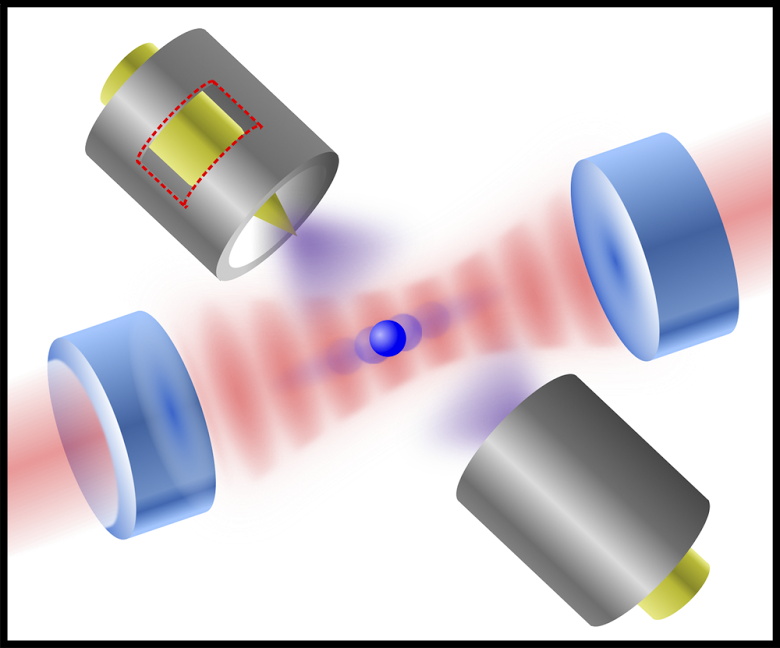How to Stop a Nanosphere
To test the limits of quantum physics, researchers would like to see macroscopic objects like nanoscale glass beads exhibiting some of the quantum weirdness familiar from atoms and sub-atomic particles. The first step is to eliminate most of the random thermal motion of such particles. Now a team has gotten close to this goal with a technique that combines two technologies—a charged-particle trap and an optical cavity—to “chill” the motion of a solid nanosphere to the equivalent of degrees above absolute zero. By modifying the cavity, the researchers say they could go further, reducing the motion enough to use a nanosphere to test quantum mechanics, as well as make highly sensitive measurements of gravity.
In the field of optomechanics, a light beam is used to reduce the motion of a nanoscale or microscale object that is often suspended on the end of a cantilever or some other spring-like support. The light is tuned to provide a damping force that reduces the amplitude of mechanical oscillations to the quantum mechanical ground state [1]. However, the object is constantly connected to the environment through its mechanical support, which complicates efforts to observe quantum effects.
One way to better isolate an object from the environment is to levitate it inside an optical cavity defined by two highly reflective mirrors. Light bouncing back and forth in the cavity forms standing waves, with highly-localized bright spots that can attract and trap a nanoparticle, similar to the mechanism in optical tweezers. Once the object is trapped and oscillating around a bright spot, the challenge is to “cool” it—reduce the amplitude of its motion—just as with mechanical oscillators. Several groups have tried to cool a nanoparticle in an optical cavity trap, but the trapping consistently fails under vacuum conditions. “It is not yet clear why the particles don’t stay in the optical cavity trap,” says Peter Barker of University College London.
Barker and his colleagues have overcome this difficulty by combining an optical cavity with a so-called Paul trap, which is used to confine ions and other charged particles. This additional trap allows the cavity laser to be less intense, potentially avoiding instabilities from internal heating of the nanoparticle through light absorption. The team placed the two cylindrical electrodes for the Paul trap perpendicular to the central axis of the -centimeter-long cavity and then encased the whole system in a vacuum chamber. The electrodes generate an electric field that—when time-averaged—resembles a kind of shallow, -micrometer-wide bowl for confining charged particles. In their experiments, the researchers chose -nanometer-wide silica beads (nanospheres), which naturally carry a small electric charge.
Due to the electric and optical forces, the nanosphere was initially confined to the axis of the cavity, where it moved back and forth from one side of the Paul trap “bowl” to the other. The particle slowed down a bit each time it hit one of the dozens of bright spots along its path, and eventually it got “stuck” in one of them, oscillating rapidly around the spot’s center. The particle’s motion continued to be reduced by a particle-cavity interaction in which the optical forces depend on the particle’s position within the light field. The Paul trap boosted the efficiency of this cooling mechanism by tugging the particle slightly away from the center of the spot to a location where the light field varied more rapidly with position.
The team showed that they could reduce the kinetic energy of the nanosphere to about times less than its initial energy in the optical trap, the equivalent of dropping its temperature to about Kelvin. They believe they can take this effective temperature down to the millikelvin range by employing better reflecting mirrors, which would strengthen the particle-cavity interaction. Future experiments might involve releasing such a bead from its trap and letting it drop through multiple “slits” made from laser beams to see whether quantum wave interference occurs. The beads could also be used to sense tiny changes in gravity or other forces.
“This work indeed constitutes a significant milestone in optomechanics and laser cooling,” says Helmut Ritsch of the University of Innsbruck in Austria. “The authors clearly prove for the first time that trapping and cavity cooling of mesoscopic objects in high vacuum is possible and only limited by cavity technology.” Angelo Bassi of the University of Trieste in Italy says that this work is a significant improvement on earlier techniques.
This research is published in Physical Review Letters.
–Michael Schirber
Michael Schirber is a Corresponding Editor for Physics Magazine based in Lyon, France.
References
- J. Chan, T. P. Mayer Alegre, A. H. Safavi-Naeini, J. T. Hill, A. Krause, S. Gröblacher, M. Aspelmeyer, and O. Painter, “Laser Cooling of a Nanomechanical Oscillator into its Quantum Ground State,” Nature 478, 89 (2011)





